7.国际会计准则
- 格式:doc
- 大小:74.00 KB
- 文档页数:23
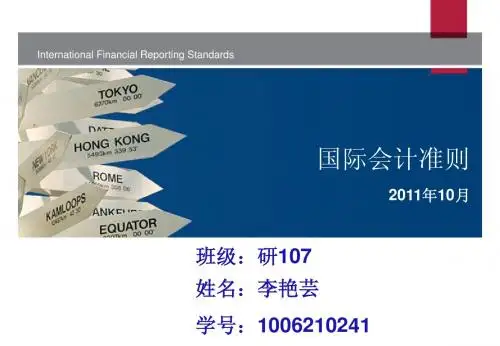
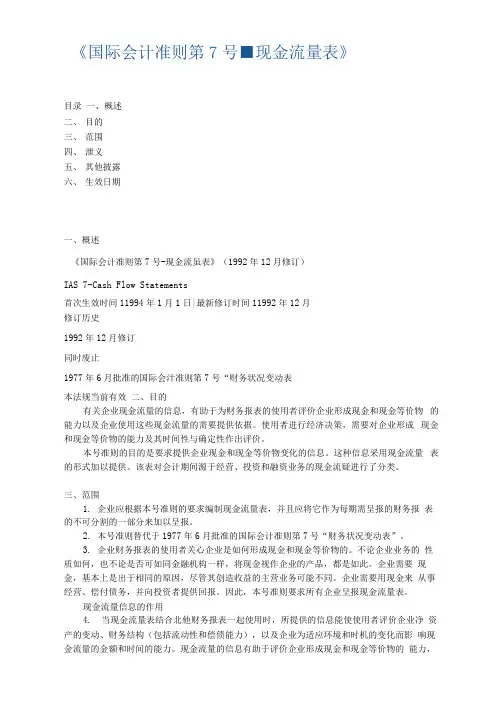
《国际会计准则第7号■现金流量表》目录一、概述二、目的三、范围四、泄义五、其他披露六、生效日期一、概述《国际会计准则第7号-现金流虽表》(1992年12月修订)IAS 7-Cash Flow Statements首次生效时间11994年1月1日|最新修订时间11992年12月修订历史1992年12月修订同时废止1977年6月批准的国际会汁准则第7号“财务状况变动表本法规当前有效二、目的有关企业现金流量的信息,有助于为财务报表的使用者评价企业形成现金和现金等价物的能力以及企业使用这些现金流量的需要提供依据。
使用者进行经济决策,需要对企业形成现金和现金等价物的能力及其时间性与确定性作出评价。
本号准则的目的是要求提供企业现金和现金等价物变化的信息。
这种信息采用现金流量表的形式加以提供。
该表对会计期间源于经营、投资和融资业务的现金流疑进行了分类。
三、范围1.企业应根据本号准则的要求编制现金流量表,并且应将它作为每期需呈报的财务报表的不可分割的一部分来加以呈报。
2.本号准则替代于1977年6月批准的国际会计准则第7号“财务状况变动表”。
3.企业财务报表的使用者关心企业是如何形成现金和现金等价物的。
不论企业业务的性质如何,也不论是否可如同金融机构一样,将现金视作企业的产品,都是如此。
企业需要现金,基本上是出于相同的原因,尽管其创造收益的主营业务可能不同。
企业需要用现金来从事经营、偿付债务,并向投资者提供回报。
因此,本号准则要求所有企业呈报现金流量表。
现金流量信息的作用4.当现金流量表结合北他财务报表一起使用时,所提供的信息能使使用者评价企业净资产的变动、财务结构(包括流动性和偿债能力),以及企业为适应环境和时机的变化而影响现金流量的金额和时间的能力。
现金流量的信息有助于评价企业形成现金和现金等价物的能力,并使使用者能够建立评价和比较不同企业未来现金流疑的现值的模式。
它还提高了不同企业经营业绩报告的可比性,因为它消除了对相同交易和事项采用不同会计处理的影响。
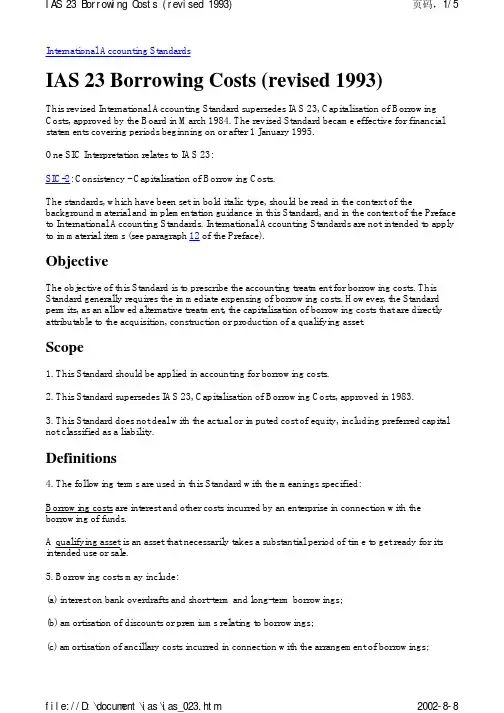
International Accounting StandardsIAS 23 Borrowing Costs (revised 1993)This revised International Accounting Standard supersedes IAS 23, Capitalisation of Borrowing Costs, approved by the Board in March 1984. The revised Standard became effective for financial statements covering periods beginning on or after 1 January 1995.One SIC Interpretation relates to IAS 23:SIC-2: Consistency - Capitalisation of Borrowing Costs.The standards, which have been set in bold italic type, should be read in the context of the background material and implementation guidance in this Standard, and in the context of the Preface to International Accounting Standards. International Accounting Standards are not intended to apply to immaterial items (see paragraph 12 of the Preface).ObjectiveThe objective of this Standard is to prescribe the accounting treatment for borrowing costs. This Standard generally requires the immediate expensing of borrowing costs. However, the Standard permits, as an allowed alternative treatment, the capitalisation of borrowing costs that are directly attributable to the acquisition, construction or production of a qualifying asset.Scope1. This Standard should be applied in accounting for borrowing costs.2. This Standard supersedes IAS 23, Capitalisation of Borrowing Costs, approved in 1983.3. This Standard does not deal with the actual or imputed cost of equity, including preferred capital not classified as a liability.Definitions4. The following terms are used in this Standard with the meanings specified:Borrowing costs are interest and other costs incurred by an enterprise in connection with the borrowing of funds.A qualifying asset is an asset that necessarily takes a substantial period of time to get ready for its intended use or sale.5. Borrowing costs may include:(a) interest on bank overdrafts and short-term and long-term borrowings;(b) amortisation of discounts or premiums relating to borrowings;(c) amortisation of ancillary costs incurred in connection with the arrangement of borrowings;(d) finance charges in respect of finance leases recognised in accordance with IAS 17, Leases; and(e) exchange differences arising from foreign currency borrowings to the extent that they are regarded as an adjustment to interest costs.6. Examples of qualifying assets are inventories that require a substantial period of time to bring them to a saleable condition, manufacturing plants, power generation facilities and investment properties. Other investments, and those inventories that are routinely manufactured or otherwise produced in large quantities on a repetitive basis over a short period of time, are not qualifying assets. Assets that are ready for their intended use or sale when acquired also are not qualifying assets.Borrowing Costs - Benchmark TreatmentRecognition7. Borrowing costs should be recognised as an expense in the period in which they are incurred.8. Under the benchmark treatment borrowing costs are recognised as an expense in the period in which they are incurred regardless of how the borrowings are applied.Disclosure9. The financial statements should disclose the accounting policy adopted for borrowing costs. Borrowing Costs - Allowed Alternative TreatmentRecognition10. Borrowing costs should be recognised as an expense in the period in which they are incurred, except to the extent that they are capitalised in accordance with paragraph 11.11. Borrowing costs that are directly attributable to the acquisition, construction or production of a qualifying asset should be capitalised as part of the cost of that asset. The amount of borrowing costs eligible for capitalisation should be determined in accordance with this Standard.[1]12. Under the allowed alternative treatment, borrowing costs that are directly attributable to the acquisition, construction or production of an asset are included in the cost of that asset. Such borrowing costs are capitalised as part of the cost of the asset when it is probable that they will result in future economic benefits to the enterprise and the costs can be measured reliably. Other borrowing costs are recognised as an expense in the period in which they are incurred.Borrowing Costs Eligible for Capitalisation13. The borrowing costs that are directly attributable to the acquisition, construction or production ofa qualifying asset are those borrowing costs that would have been avoided if the expenditure on the qualifying asset had not been made. When an enterprise borrows funds specifically for the purpose of obtaining a particular qualifying asset, the borrowing costs that directly relate to that qualifying asset can be readily identified.14. It may be difficult to identify a direct relationship between particular borrowings and a qualifying asset and to determine the borrowings that could otherwise have been avoided. Such a difficultyoccurs, for example, when the financing activity of an enterprise is co-ordinated centrally. Difficulties also arise when a group uses a range of debt instruments to borrow funds at varying rates of interest, and lends those funds on various bases to other enterprises in the group. Other complications arise through the use of loans denominated in or linked to foreign currencies, when the group operates in highly inflationary economies, and from fluctuations in exchange rates. As a result, the determination of the amount of borrowing costs that are directly attributable to the acquisition ofa qualifying asset is difficult and the exercise of judgement is required.15. To the extent that funds are borrowed specifically for the purpose of obtaining a qualifying asset, the amount of borrowing costs eligible for capitalisation on that asset should be determined as the actual borrowing costs incurred on that borrowing during the period less any investment income on the temporary investment of those borrowings.16. The financing arrangements for a qualifying asset may result in an enterprise obtaining borrowed funds and incurring associated borrowing costs before some or all of the funds are used for expenditures on the qualifying asset. In such circumstances, the funds are often temporarily invested pending their expenditure on the qualifying asset. In determining the amount of borrowing costs eligible for capitalisation during a period, any investment income earned on such funds is deducted from the borrowing costs incurred.17. To the extent that funds are borrowed generally and used for the purpose of obtaining a qualifying asset, the amount of borrowing costs eligible for capitalisation should be determined by applying a capitalisation rate to the expenditures on that asset. The capitalisation rate should be the weighted average of the borrowing costs applicable to the borrowings of the enterprise that are outstanding during the period, other than borrowings made specifically for the purpose of obtaining a qualifying asset. The amount of borrowing costs capitalised during a period should not exceed the amount of borrowing costs incurred during that period.18. In some circumstances, it is appropriate to include all borrowings of the parent and its subsidiaries when computing a weighted average of the borrowing costs; in other circumstances, it is appropriate for each subsidiary to use a weighted average of the borrowing costs applicable to its own borrowings.Excess of the Carrying Amount of the Qualifying Asset over Recoverable Amount19. When the carrying amount or the expected ultimate cost of the qualifying asset exceeds its recoverable amount or net realisable value, the carrying amount is written down or written off in accordance with the requirements of other International Accounting Standards. In certain circumstances, the amount of the write-down or write-off is written back in accordance with those other International Accounting Standards.Commencement of Capitalisation20. The capitalisation of borrowing costs as part of the cost of a qualifying asset should commence when:(a) expenditures for the asset are being incurred;(b) borrowing costs are being incurred; and(c) activities that are necessary to prepare the asset for its intended use or sale are in progress.21. Expenditures on a qualifying asset include only those expenditures that have resulted in payments of cash, transfers of other assets or the assumption of interest-bearing liabilities.Expenditures are reduced by any progress payments received and grants received in connection with the asset (see IAS 20, Accounting for Government Grants and Disclosure of Government Assistance). The average carrying amount of the asset during a period, including borrowing costs previously capitalised, is normally a reasonable approximation of the expenditures to which the capitalisation rate is applied in that period.22. The activities necessary to prepare the asset for its intended use or sale encompass more than the physical construction of the asset. They include technical and administrative work prior to the commencement of physical construction, such as the activities associated with obtaining permits prior to the commencement of the physical construction. However, such activities exclude the holding of an asset when no production or development that changes the asset's condition is taking place. For example, borrowing costs incurred while land is under development are capitalised during the period in which activities related to the development are being undertaken. However, borrowing costs incurred while land acquired for building purposes is held without any associated development activity do not qualify for capitalisation.Suspension of Capitalisation23. Capitalisation of borrowing costs should be suspended during extended periods in which active development is interrupted.24. Borrowing costs may be incurred during an extended period in which the activities necessary to prepare an asset for its intended use or sale are interrupted. Such costs are costs of holding partially completed assets and do not qualify for capitalisation. However, capitalisation of borrowing costs is not normally suspended during a period when substantial technical and administrative work is being carried out. Capitalisation of borrowing costs is also not suspended when a temporary delay is a necessary part of the process of getting an asset ready for its intended use or sale. For example, capitalisation continues during the extended period needed for inventories to mature or the extended period during which high water levels delay construction of a bridge, if such high water levels are common during the construction period in the geographic region involved.Cessation of Capitalisation25. Capitalisation of borrowing costs should cease when substantially all the activities necessary to prepare the qualifying asset for its intended use or sale are complete.26. An asset is normally ready for its intended use or sale when the physical construction of the asset is complete even though routine administrative work might still continue. If minor modifications, such as the decoration of a property to the purchaser's or user's specification, are all that are outstanding, this indicates that substantially all the activities are complete.27. When the construction of a qualifying asset is completed in parts and each part is capable of being used while construction continues on other parts, capitalisation of borrowing costs should cease when substantially all the activities necessary to prepare that part for its intended use or sale are completed.28. A business park comprising several buildings, each of which can be used individually is an example of a qualifying asset for which each part is capable of being usable while construction continues on other parts. An example of a qualifying asset that needs to be complete before any part can be used is an industrial plant involving several processes which are carried out in sequence at different parts of the plant within the same site, such as a steel mill.Disclosure29. The financial statements should disclose:(a) the accounting policy adopted for borrowing costs;(b) the amount of borrowing costs capitalised during the period; and(c) the capitalisation rate used to determine the amount of borrowing costs eligible for capitalisation. Transitional Provisions30. When the adoption of this Standard constitutes a change in accounting policy, an enterprise is encouraged to adjust its financial statements in accordance with IAS 8, Net Profit or Loss for the Period, Fundamental Errors and Changes in Accounting Policies. Alternatively, enterprises following the allowed alternative treatment should capitalise only those borrowing costs incurred after the effective date of the Standard which meet the criteria for capitalisation.Effective Date31. This International Accounting Standard becomes operative for financial statements covering periods beginning on or after 1 January 1995.[1]See also SIC - 2, Consistency - Capitalisation of Borrowing Costs.。
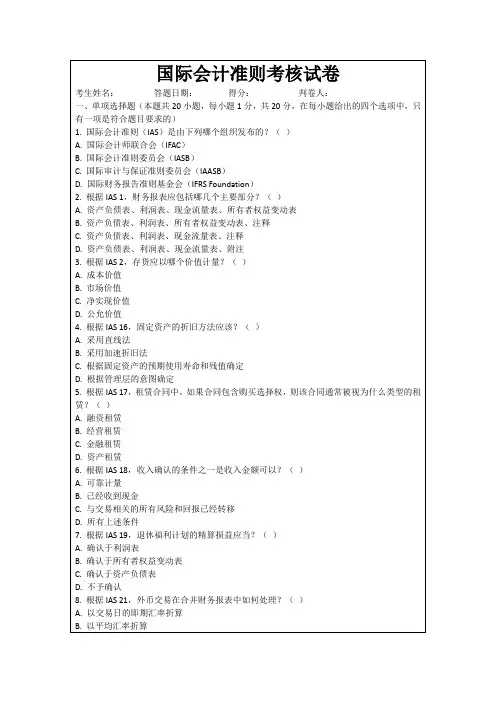
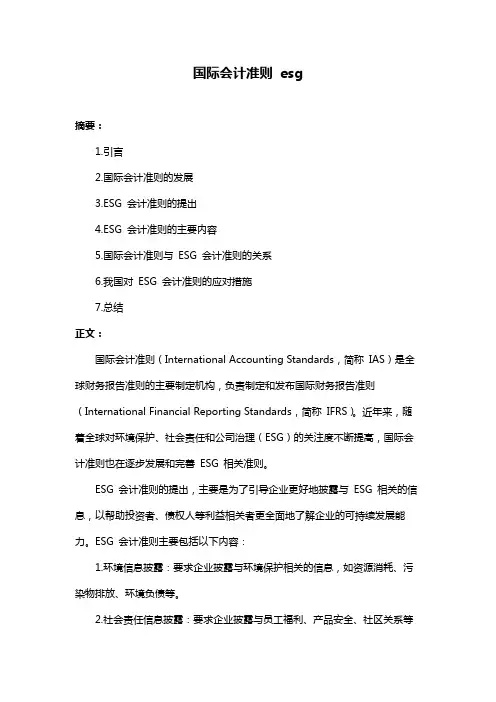
国际会计准则esg摘要:1.引言2.国际会计准则的发展3.ESG 会计准则的提出4.ESG 会计准则的主要内容5.国际会计准则与ESG 会计准则的关系6.我国对ESG 会计准则的应对措施7.总结正文:国际会计准则(International Accounting Standards,简称IAS)是全球财务报告准则的主要制定机构,负责制定和发布国际财务报告准则(International Financial Reporting Standards,简称IFRS)。
近年来,随着全球对环境保护、社会责任和公司治理(ESG)的关注度不断提高,国际会计准则也在逐步发展和完善ESG 相关准则。
ESG 会计准则的提出,主要是为了引导企业更好地披露与ESG 相关的信息,以帮助投资者、债权人等利益相关者更全面地了解企业的可持续发展能力。
ESG 会计准则主要包括以下内容:1.环境信息披露:要求企业披露与环境保护相关的信息,如资源消耗、污染物排放、环境负债等。
2.社会责任信息披露:要求企业披露与员工福利、产品安全、社区关系等方面有关的信息。
3.公司治理信息披露:要求企业披露与公司治理结构、内部控制、股东权益等方面有关的信息。
国际会计准则与ESG 会计准则之间存在密切关系。
一方面,国际会计准则为ESG 会计准则提供了基本的财务报告框架,ESG 会计准则可以借鉴和应用国际会计准则的相关原则和方法;另一方面,ESG 会计准则是对国际会计准则的补充和完善,可以帮助企业更好地满足利益相关者的信息需求。
面对国际会计准则的ESG 发展,我国也在积极应对。
我国财政部于2018 年发布了《企业可持续发展报告编制指引》,对企业披露ESG 信息提出了明确要求。
此外,我国还在不断推动企业披露ESG 信息的相关政策法规建设,以促进我国企业更好地履行社会责任。
总之,国际会计准则的ESG 发展对我国企业具有重要影响。
我国企业应积极响应国际会计准则的ESG 要求,加强ESG 信息披露,提升企业的可持续发展能力。

国际会计准则2003年9月19日国际会计准则(IAS)目录Framework for the Preparation and Presentation of Financial Statements (3)Preface ...................................................................... .............................................................................. . (24)Procedure and Objective of IASB ......................................................................... (27)IAS 1: Presentation of Financial Statements.................................................................... (33)IAS 2: Inventories................................................................... .............................................................................. .55IAS 7: Cash Flow Statements ................................................................... (62)IAS 8: Net Profit or Loss for the Period, Fundamental Errors and Changes in Accounting Policies (73)IAS 10: Events After the Balance Sheet Date.......................................................................... (82)IAS 11: Construction Contracts .................................................................... .. (93)IAS 12: Income Taxes ........................................................................ (101)IAS 14: Segment Reporting .................................................................... (134)IAS 15: Information Reflecting the Effects of Changing Prices (1)50IAS 16: Property, Plant and Equipment..................................................................... . (155)IAS 17: Leases........................................................................ (169)IAS 18: Revenue ...................................................................... . (18)IAS 19: Employee Benefits...................................................................... (188)IAS 20: Accounting for Government Grants and Disclosure of Government Assistance (227)IAS 21: The Effects of Changes in Foreign Exchange Rates ........................................................................ . (233)IAS 22: Business Combinations.................................................................. .. (244)IAS 23: Borrowing Costs ........................................................................ (270)IAS 24: Related Party Disclosures .................................................................. . (275)IAS 26: Accounting and Reporting by Retirement Benefit Plans (280)IAS 27: Consolidated Financial Statements ................................................................... (288)IAS 28: Investments in Associates ................................................................... . (294)IAS 29: Financial Reporting in Hyperinflationary Economies .................................................................... . (301)IAS 30: Disclosures in the Financial Statements of Banks and Similar Financial Institutions (308)IAS 31: Financial Reporting of Interests in Joint Ventures ..................................................................... (319)IAS 32: Financial Instruments: Disclosure and Presentation.................................................................. (328)IAS 33: Earnings per Share ........................................................................ .. (351)IAS 34: Interim Financial Reporting..................................................................... (365)IAS 35: Discontinuing Operations ................................................................... (376)IAS 36: Impairment of Assets........................................................................ .. (385)IAS 37: Provisions, Contingent Liabilities and Contingent Assets (410)IAS 38: Intangible Assets ....................................................................... . (426)IAS 39: Financial Instruments: Recognition and Measurement................................................................... (452)IAS 40: InvestmentProperty...................................................................... .. (504)IAS 41: Agriculture .................................................................. (520)Framework for the Preparation and Presentation of Financial StatementsFramework for the Preparation and Presentation of Financial Statements架The IASB Framework is a conceptual accounting framework that sets out the concepts that underlie thepreparation and presentation of financial statements for external users. It was approved in 1989. The IASBFramework assists the IASB:.in the development of future International Accounting Standards and in its review of existingInternational Accounting Standards; and.in promoting the harmonisation of regulations, accounting standards and procedures relating to thepresentation of financial statements by providing a basis for reducing the number of alternativeaccounting treatments permitted by International Accounting Standards.In addition, the Framework may assist:.preparers of financial statements in applying International Accounting Standards and in dealing withtopics that have yet to form the subject of an International Accounting Standard;.auditors in forming an opinion as to whether financial statements conform with InternationalAccounting Standards;.users of financial statements in interpreting the information contained in financial statements preparedin conformity with International Accounting Standards; and.those who are interested in the work of IASB, providing them with information about its approach to theformulation of accounting standards.The Framework is not an International Accounting Standard and does not define standards for any particularmeasurement or disclosure issue.In a limited number of cases there may be a conflict between the Framework and a requirement within anInternational Accounting Standard. In those cases where there is a conflict, the requirements of the InternationalAccounting Standard prevail over those of the Framework.世界上许多企业都编制并且向外部使用者呈报财务报表。
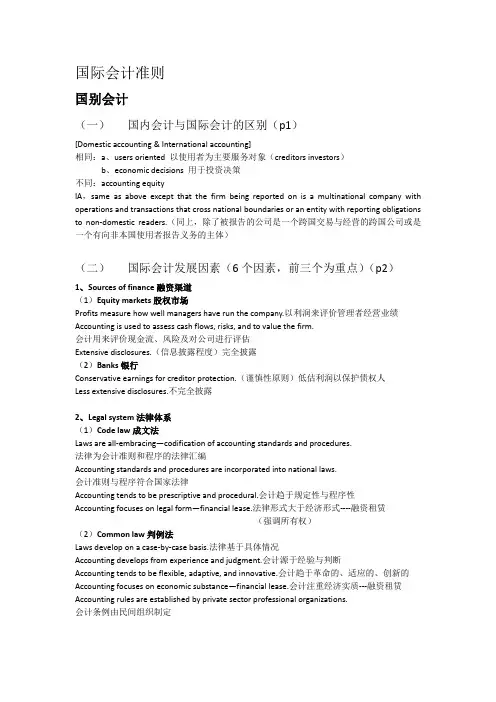
国际会计准则国别会计(一)国内会计与国际会计的区别(p1)[Domestic accounting & International accounting]相同:a、users oriented 以使用者为主要服务对象(creditors investors)b、economic decisions 用于投资决策不同:accounting equityIA,same as above except that the firm being reported on is a multinational company with operations and transactions that cross national boundaries or an entity with reporting obligations to non-domestic readers.(同上,除了被报告的公司是一个跨国交易与经营的跨国公司或是一个有向非本国使用者报告义务的主体)(二)国际会计发展因素(6个因素,前三个为重点)(p2)1、Sources of finance融资渠道(1)Equity markets股权市场Profits measure how well managers have run the company.以利润来评价管理者经营业绩Accounting is used to assess cash flows, risks, and to value the firm.会计用来评价现金流、风险及对公司进行评估Extensive disclosures.(信息披露程度)完全披露(2)Banks银行Conservative earnings for creditor protection.(谨慎性原则)低估利润以保护债权人Less extensive disclosures.不完全披露2、Legal system法律体系(1)Code law成文法Laws are all-embracing—codification of accounting standards and procedures.法律为会计准则和程序的法律汇编Accounting standards and procedures are incorporated into national laws.会计准则与程序符合国家法律Accounting tends to be prescriptive and procedural.会计趋于规定性与程序性Accounting focuses on legal form—financial lease.法律形式大于经济形式----融资租赁(强调所有权)(2)Common law判例法Laws develop on a case-by-case basis.法律基于具体情况Accounting develops from experience and judgment.会计源于经验与判断Accounting tends to be flexible, adaptive, and innovative.会计趋于革命的、适应的、创新的Accounting focuses on economic substance—financial lease.会计注重经济实质---融资租赁Accounting rules are established by private sector professional organizations.会计条例由民间组织制定3、Taxation课税(税法)Must companies record revenues and expenses in their accounts to claim them for tax purposes?公司是否必须在他们的账户上按税法记录收入与费用Are financial accounting and taxation the same?财税合一?--Germany德国Or are they different?财税分离--U.S.A. or Sweden (瑞典)--LIFO Conformity Rule in USA对LIFO来说,会计法和税法是一样的4. Political and economic ties政治与经济的联系5. Inflation通货膨胀6. Level of economic development经济发展程度7. Educational level教育水平•SUMMARY–Several variables are closely associated.•Common law legal system, strong equity markets, and separation of financial and tax accounting. •Code law legal system, credit-based(以信贷为基础)financing, and accounting rules that conform to(符合)tax law.–Result is two basic orientations of accounting.•Fair presentation公允披露•Legal compliance遵循法规(三)国际会计发展分类(p2-p3)三种分类方法:第一种,四分类Four approachesA. Macroeconomic approach宏观经济角度Accounting derived from and designed to enhance national macroeconomic goals–stable employment policy平稳的就业政策–smooth income利润平滑性–the development of certain industry相关产业的发展Example: Sweden(瑞典强调财税合一,以税法为导向,以国家为主要的服务目标)B. Microeconomic approach微观经济角度Its focus is on individual firms whose main goal is to survive(独立企业)以企业为主体,防范企业破产,保护企业利益Accounting derived from microeconomics.–Maintaining physical capital 资产保全(更多强调企业现金流)–Separation of capital and income现金流与利润分离–Replacement costs重置成本(与市场价值接轨)Example: the NetherlandsC. Independent discipline approach独立准则(财税分离)•Accounting derived from business practices, judgment, and trial-and-error.•Examples: U.K. and U.S.D. Uniform approach统一性原则(会计准则、税法与相关法律一致)•Accounting is standardized by central government and used as a tool for administrative control.•Example: France第二种,法律体系分类Legal systemsA. Common law accounting判例法系•Oriented toward fair presentation, transparency, and full disclosure以公允披露、高信息透明度、完全披露原则为导向•Separation between tax and financial accounting•Accounting standard setting in private sector编制会计准则主体一般为民间机构•Parallels stockholder model(模型)of corporate governance–Full disclosure resolves the information asymmetry完全披露原则,解决信息不对称【判例法系:以股权融资为主,满足投资者利益,为投资者服务】B. Code law accounting成文法系•Legalistic orientation, opaque with low disclosure法律方向、模糊披露•Alignment(一致的)between tax and financial accounting•Accounting standard setting(编制)in public sector(政府)•Parallels stakeholder(利益相关方,此处主要指政府)model of corporate governance–Debt more important source of finance融资渠道主要是债权人(政府)–Conservative measurement as a cushion谨慎性计量作为保障第三种,实务角度分类Practice systemsA. Fair presentation accounting公允披露•Substance over form实质重于形式–Depreciation expense 确认折旧费用–Financial lease or operating lease融资or经营•Oriented toward decision needs of external investors.以外部信息使用者利益为导向–Helps judge managerial performance and predict future cash flows and profitability 提升企业管理业绩,预期企业现金流及利润(经营权、所有权分离)–Extensive disclosures详细披露•IFRS are aimed at fair presentation. 以公允披露为导向编制财报•Found in U.K., U.S., Netherlands and countries influenced by them.•The trend for consolidated(合并)financial statements.B. Legal compliance accounting•Designed to satisfy government-imposed requirements, such as:以政府利益为主–Calculating taxable income应计纳税报表–Complying with macroeconomic plan与宏观计划相一致•Conservative measurements谨慎性计量•Income smoothing平滑利润的目标•Will persist in code law countries for individual-company financial statements 只遵守本国国内的会计准则简答题:Why national accounting distinctions are becoming blurred(模糊的)为什么国别会计的差异趋于模糊?•Importance of stock markets as a source of finance is growing.资本市场(股权融资)重要性•Dual financial reporting(财务报表双轨制)is becoming more common, particularly where duality is sanctioned.–Individual company/financial statement国内独立企业(非上市公司,non-listed company)[可按本国财务报表编制]–Consolidated financial statement上市公司的合并财务报表•Some code law countries are shifting responsibility for accounting standard setting to the private sector.一些成文法系的国家将编制会计准则的责任交给民间机构双轨制:即既要遵守国内的准则,又要遵守国外的。
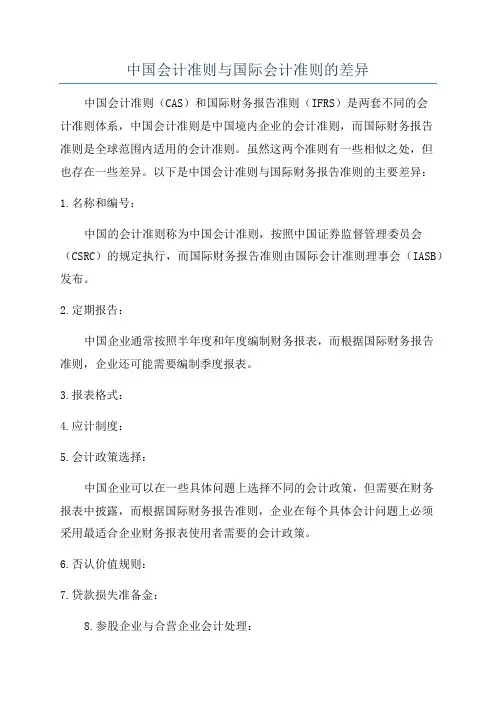
中国会计准则与国际会计准则的差异
中国会计准则(CAS)和国际财务报告准则(IFRS)是两套不同的会
计准则体系,中国会计准则是中国境内企业的会计准则,而国际财务报告
准则是全球范围内适用的会计准则。
虽然这两个准则有一些相似之处,但
也存在一些差异。
以下是中国会计准则与国际财务报告准则的主要差异:1.名称和编号:
中国的会计准则称为中国会计准则,按照中国证券监督管理委员会(CSRC)的规定执行,而国际财务报告准则由国际会计准则理事会(IASB)发布。
2.定期报告:
中国企业通常按照半年度和年度编制财务报表,而根据国际财务报告
准则,企业还可能需要编制季度报表。
3.报表格式:
4.应计制度:
5.会计政策选择:
中国企业可以在一些具体问题上选择不同的会计政策,但需要在财务
报表中披露,而根据国际财务报告准则,企业在每个具体会计问题上必须
采用最适合企业财务报表使用者需要的会计政策。
6.否认价值规则:
7.贷款损失准备金:
8.参股企业与合营企业会计处理:
9.资产计量:
10.披露要求:
总体来说,中国会计准则和国际财务报告准则在许多方面存在差异。
对于国际化的企业来说,理解并熟悉这些差异的影响是至关重要的,以确
保财务报表的准确和一致,同时满足相关的法律、法规和会计准则的要求。
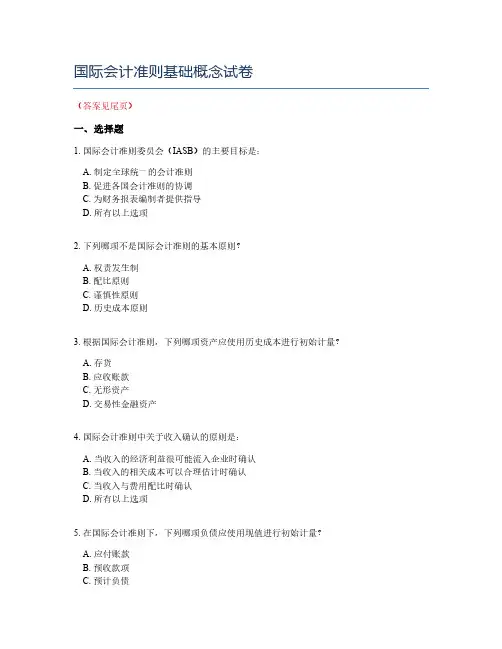
国际会计准则基础概念试卷(答案见尾页)一、选择题1. 国际会计准则委员会(IASB)的主要目标是:A. 制定全球统一的会计准则B. 促进各国会计准则的协调C. 为财务报表编制者提供指导D. 所有以上选项2. 下列哪项不是国际会计准则的基本原则?A. 权责发生制B. 配比原则C. 谨慎性原则D. 历史成本原则3. 根据国际会计准则,下列哪项资产应使用历史成本进行初始计量?A. 存货B. 应收账款C. 无形资产D. 交易性金融资产4. 国际会计准则中关于收入确认的原则是:A. 当收入的经济利益很可能流入企业时确认B. 当收入的相关成本可以合理估计时确认C. 当收入与费用配比时确认D. 所有以上选项5. 在国际会计准则下,下列哪项负债应使用现值进行初始计量?A. 应付账款B. 预收款项C. 预计负债D. 长期借款6. 国际会计准则中关于合并财务报表的规定,下列哪项说法是正确的?A. 母公司对所有子公司的投资均按权益法核算B. 当母公司对子公司拥有控制权时,子公司应纳入合并财务报表C. 子公司少数股东权益在合并资产负债表中单独列示D. 所有以上选项7. 根据国际会计准则,下列哪种情况下,资产可以重估?A. 当资产的市场价值持续上升时B. 当资产的重估价值高于其账面价值时C. 当资产的使用寿命发生变化时D. 当资产预计未来现金流量增加时8. 国际会计准则中关于金融工具的披露要求,下列哪项是不正确的?A. 金融资产应按照公允价值进行计量,且变动应计入当期损益B. 金融资产和金融负债应在资产负债表内分别列示C. 金融工具的公允价值变动应计入所有者权益D. 所有以上选项9. 根据国际会计准则,下列哪种情况下,不应终止确认一项金融资产?A. 金融资产已转让给第三方B. 金融资产已出售但买方尚未付款C. 金融资产被用作担保物D. 金融资产因违约而被收回10. 国际会计准则中关于关联方披露的要求,下列哪项是不正确的?A. 企业应披露与其有重大关联关系的方的信息B. 关联方交易应在附注中进行披露C. 关联方关系是指控制、共同控制和重大影响D. 所有以上选项11. 国际会计准则理事会(IASB)的主要目标是:A. 制定全球统一的会计准则B. 促进各国会计准则的协调C. 为财务报表编制者提供指导D. 所有以上选项12. 在国际会计准则中,关于收入确认的说法,以下哪项是正确的?A. 当企业已经履行了其主要义务时,即可确认收入B. 收入确认应当在商品或服务的风险和报酬转移给客户时C. 收入确认应当在企业有经济利益流入时D. 收入确认应当在企业完成销售合同的所有步骤时13. 国际会计准则中,对于合并财务报表的规定,以下哪项是不正确的?A. 母公司应当对所有子公司的财务报表进行合并B. 合并财务报表应当反映整个集团的财务状况和经营成果C. 对于不重要的子公司,可以不纳入合并范围D. 合并财务报表应当遵循个别会计准则14. 在国际会计准则中,关于资产减值的规定,以下哪项是正确的?A. 当资产的可回收金额低于其账面价值时,应当计提减值准备B. 资产减值准备应当在每个资产负债表日进行测试C. 资产减值准备的计提应当基于历史成本减去累计折旧D. 资产减值准备可以在利润表中确认为费用15. 国际会计准则中,关于金融工具的分类和计量的规定,以下哪项是不正确的?A. 金融工具可以分为以公允价值计量且其变动计入当期损益的金融资产和金融负债B. 以公允价值计量且其变动计入当期损益的金融资产应当以公允价值计量C. 以摊余成本计量的金融资产可以重分类为以公允价值计量且其变动计入当期损益的金融资产D. 金融工具的计量应当考虑所有市场参与者假设16. 在国际会计准则中,关于关联方披露的规定,以下哪项是正确的?A. 企业应当披露与其有重大关联关系的所有方B. 关联方关系是指控制、共同控制和重大影响关系C. 关联方交易应当在附注中进行披露D. 所有以上选项17. 国际会计准则中,关于财务报表附注的规定,以下哪项是不正确的?A. 附注是财务报表的重要组成部分B. 附注应当提供足够的信息,以便使用者理解财务报表的内容C. 附注应当包括企业的简介和主要财务指标D. 附注不应当包括会计政策、估计和假设的变更18. 在国际会计准则中,关于存货的规定,以下哪项是正确的?A. 存货应当按照成本进行初始计量B. 存货的期末计量应当采用成本与可变现净值孰低法C. 存货的跌价准备应当在期末时计提D. 所有以上选项19. 国际会计准则中,关于投资性房地产的规定,以下哪项是不正确的?A. 投资性房地产是指为赚取租金或资本增值,或两者兼有而持有的房地产B. 投资性房地产应当采用公允价值模式进行后续计量C. 投资性房地产的转换应当作为会计政策变更处理D. 投资性房地产的公允价值变动应当计入当期损益20. 在国际会计准则下,下列哪项负债应使用公允价值进行初始计量?A. 应付账款B. 短期借款C. 预计负债D. 应付债券21. 根据国际会计准则,下列哪项不属于会计信息的质量要求?A. 可靠性B. 相关性C. 可理解性D. 谨慎性22. 国际会计准则中关于合并财务报表的规定,以下哪项陈述是正确的?A. 母公司对所有子公司拥有100%的股份B. 子公司可以是母公司的一个部门C. 所有子公司必须采用相同的会计政策D. 母公司只有在子公司盈利时才需要编制合并财务报表23. 在国际会计准则中,下列哪项不属于财务报表的组成部分?A. 资产负债表B. 利润表C. 现金流量表D. 所有者权益变动表24. 根据国际会计准则,下列哪项资产减值损失一经确认,不允许转回?A. 长期股权投资B. 无形资产C. 存货D. 应收账款25. 国际会计准则中关于关联方披露的规定,以下哪项陈述是正确的?A. 关联方必须是企业的子公司B. 关联方关系包括控制、共同控制和重大影响C. 企业与关联方的交易必须披露D. 所有以上选项26. 在国际会计准则中,对于收入确认的标准是什么?A. 当企业获得经济利益时B. 当商品或服务的风险转移给买方时C. 当收入金额可以可靠计量,且经济利益很可能流入企业时D. 当与交易相关的义务解除时27. 国际会计准则中关于资产减值的规定,要求企业必须定期进行减值测试,以下哪项不是减值测试的依据?A. 资产的实际使用状况B. 资产的预计未来现金流量C. 资产的市场价值D. 资产的历史成本减去累计折旧28. 在国际会计准则下,对于合并财务报表的处理,以下哪项描述是不正确的?A. 子公司少数股东权益在合并报表中单独列示B. 母公司对于子公司不具有控制权时,只需将子公司的资产和负债纳入合并报表C. 汇率变动对合并报表有影响D. 所有子公司必须完全纳入合并报表范围29. 国际会计准则中关于金融工具的分类和计量,以下哪项说法是正确的?A. 金融资产只能分为以公允价值计量且其变动计入当期损益的金融资产和以公允价值计量且其变动计入其他综合收益的金融资产B. 所有金融资产均以公允价值计量,且其变动均计入当期损益C. 金融负债只能以摊余成本计量D. 以公允价值计量且其变动计入其他综合收益的金融资产,其公允价值变动不影响当期损益30. 在国际会计准则中,关于租赁的会计处理,以下哪项描述是不准确的?A. 融资租赁中,承租人将租赁资产视为自有资产进行会计处理B. 经营租赁中,出租人不将租赁资产资本化C. 租赁期占租赁资产使用寿命的大部分,应视为融资租赁D. 所有租赁均需区分融资租赁和经营租赁31. 国际会计准则对于关联方披露的要求,以下哪项是不必要的?A. 披露关联方关系的性质B. 披露与关联方发生的所有交易C. 披露关联方交易的定价政策D. 披露关联方在本期开始前的交易32. 在国际会计准则下,关于报告期的划分,以下哪项是不正确的?A. 报告期可以是自然年度B. 报告期可以是营业年度C. 报告期必须与资产负债表日保持一致D. 报告期可以根据企业的需要随意划分33. 国际会计准则对于会计政策的变更,要求企业必须进行追溯调整,以下哪项不是追溯调整的理由?A. 会计政策变更导致资产或负债的账面价值发生变化B. 会计政策变更导致以前期间的收益或费用发生变动C. 会计政策变更使得以前期间的会计估计更加准确D. 会计政策变更仅仅是为了符合最新的法规要求34. 根据国际会计准则,下列哪项属于资产?A. 预付款项B. 应收账款C. 无形资产D. 所有以上选项35. 在国际会计准则下,下列哪项不属于负债?A. 应付账款B. 预计负债C. 递延所得税负债D. 所有以上选项36. 国际会计准则中,关于收入确认的原则是:A. 当收入的经济利益很可能流入企业时B. 当收入的成本可以合理估计时C. 当与交易相关的经济利益很可能流入企业,且收入的金额可以可靠计量时D. 所有以上选项37. 下列哪项不是国际会计准则中关于利润表的要求?A. 利润表应反映企业在一定会计期间的经营成果B. 利润表应包括所有重要的收入和费用项目C. 利润表应单独列报每股收益D. 利润表应按照权责发生制编制38. 根据国际会计准则,下列哪项属于所有者权益?A.股本B. 资本公积C. 未分配利润D. 所有以上选项39. 国际会计准则中,关于合并财务报表的要求包括:A. 所有控制下的子公司都应纳入合并财务报表B. 子公司少数股东权益应在合并资产负债表中单独列报C. 合并财务报表应提供母公司及其子公司各自的财务状况和经营成果D. 所有以上选项40. 下列哪项不是国际会计准则中关于关联方披露的要求?A. 企业应披露与其有重大关联关系的方B. 企业应披露与关联方的交易类型、金额及条件C. 企业应披露关联方关系的性质、交易的目的以及交易对企业的经济影响D. 企业只需披露与其有重大关联关系的方,无需披露交易的目的和经济影响41. 国际会计准则中,关于财务报告编制的要求包括:A. 财务报告应清晰、准确、无重大差错B. 财务报告应提供足够的信息,以便使用者评估企业的财务状况、经营成果和现金流量C. 财务报告应按照权责发生制编制D. 所有以上选项二、问答题1. 什么是国际会计准则(IAS)?2. 国际会计准则的主要目标是什么?3. 国际会计准则理事会(IASB)是如何运作的?4. 国际会计准则中关于资产和负债的确认标准是什么?5. 国际会计准则中关于收入和费用的确认原则是什么?6. 国际会计准则中关于合并财务报表的规定是什么?7. 国际会计准则中关于金融工具的会计处理是如何规定的?8. 国际会计准则中关于关联方披露的要求是什么?参考答案选择题:1. D2. D3. A4. A5. C6. B7. B8. C9. B 10. B11. D 12. A 13. D 14. A 15. C 16. D 17. D 18. B 19. C 20. D21. D 22. C 23. D 24. B 25. B 26. C 27. D 28. B 29. A 30. D31. B 32. D 33. D 34. D 35. C 36. C 37. D 38. D 39. D 40. D41. D问答题:1. 什么是国际会计准则(IAS)?国际会计准则是由国际会计准则理事会(IASB)制定的一系列会计标准,旨在提供一套高质量的、可理解的、可比较的国际会计标准,以帮助财务报表编制者和使用者做出经济决策。

国际会计准则(中文版)【完整版】(文档可以直接使用,也可根据实际需要修订后使用,可编辑放心下载)国际会计准那么〔中文版〕国际会计准那么〔中文版〕International Accounting Standards Chinese Edition目录7>1国际会计准那么第1号--会计政策的揭示4国际会计准那么第2号--存货10国际会计准那么第3号--已失效10国际会计准那么第4号--折旧会计13国际会计准那么第5号--已失效13国际会计准那么第6号--已失效13国际会计准那么第7号--现金流量表21国际会计准那么第8号--本期净损益、根本错误和会计政策的变更29国际会计准那么第9号--研究和开发费用35国际会计准那么第10号--或有事项和资产负债表日以后发生的事项39国际会计准那么第11号--建筑合同46国际会计准那么第12号--所得税会计53国际会计准那么第13号--已失效54国际会计准那么第14号--按分部报告财务信息58国际会计准那么第15号--反映价格变动影响的信息61国际会计准那么第16号--不动产、厂房和设备73国际会计准那么第17号--租赁会计82国际会计准那么第18号--收入89国际会计准那么第19号--退休金费用97国际会计准那么第20号--政府补助会计和对政府援助的揭示103国际会计准那么第21号--外汇汇率变动的影响111国际会计准那么第22号--企业合并124国际会计准那么第23号--借款费用128国际会计准那么第24号--对关联者的揭示132国际会计准那么第25号--投资会计140国际会计准那么第26号--退休金方案的会计和报告147国际会计准那么第27号--合并财务报表和对附属公司投资的会计152国际会计准那么第28号--对联营企业投资的会计156国际会计准那么第29号--在恶性通货膨胀经济中的财务报告161国际会计准那么第30号--银行和类似金融机构财务报表应揭示的信息171国际会计准那么第31号--合营中权益的财务报告178国际会计准那么第32号--金融工具:揭示和呈报197国际会计准那么第33号--每股收益208国际会计准那么第34号--中期财务报告216国际会计准那么第35号--中止经营223国际会计准那么第36号--资产减值242国际会计准那么第37号--准备、或有负债和或有资产255国际会计准那么第38号--无形资产275国际会计准那么第39号--金融工具:确认和计量313国际会计准那么第40号--投资性房地产325国际会计准那么第41号--农业国际会计准那么第1号--会计政策的揭示〔1975年1月公布,1994年11月格式重排〕范围13>.在揭示编制和呈报财务报表所采用的所有重要会计政策时,应该应用本号准那么。
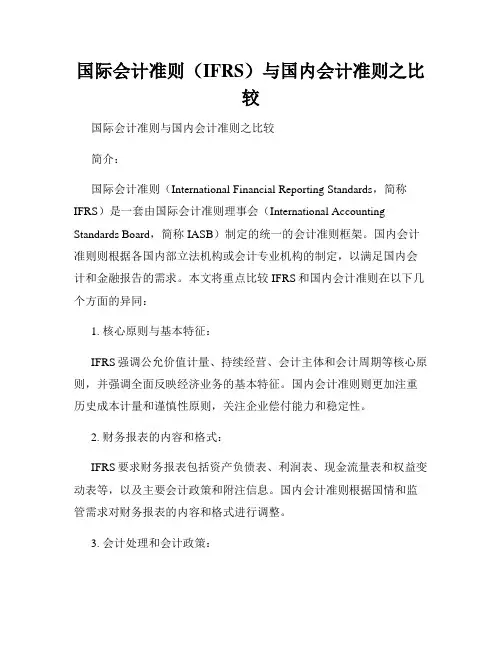
国际会计准则(IFRS)与国内会计准则之比较国际会计准则与国内会计准则之比较简介:国际会计准则(International Financial Reporting Standards,简称IFRS)是一套由国际会计准则理事会(International Accounting Standards Board,简称IASB)制定的统一的会计准则框架。
国内会计准则则根据各国内部立法机构或会计专业机构的制定,以满足国内会计和金融报告的需求。
本文将重点比较IFRS和国内会计准则在以下几个方面的异同:1. 核心原则与基本特征:IFRS强调公允价值计量、持续经营、会计主体和会计周期等核心原则,并强调全面反映经济业务的基本特征。
国内会计准则则更加注重历史成本计量和谨慎性原则,关注企业偿付能力和稳定性。
2. 财务报表的内容和格式:IFRS要求财务报表包括资产负债表、利润表、现金流量表和权益变动表等,以及主要会计政策和附注信息。
国内会计准则根据国情和监管需求对财务报表的内容和格式进行调整。
3. 会计处理和会计政策:IFRS对于会计处理和会计政策给予较大的灵活性,允许企业根据实际情况选择合适的会计政策。
国内会计准则则相对更为规范,少有选择权,强制执行标准的会计处理和会计政策。
4. 公司合并与业务组合:IFRS对于公司合并与业务组合的会计处理更加详细和具体,要求按照市场价值进行资产和负债的确认和计量。
国内会计准则则对公司合并和业务组合的会计处理相对较为简化,侧重于合并方案的编制和披露。
5. 资本化与费用化的界定:IFRS对于资本化与费用化的界定较为灵活,要求企业根据可确认的未来经济利益和相关成本的可计量性做出判断。
国内会计准则则相对更为严格,要求企业按照成本的发生顺序和可确认的未来经济利益进行界定。
6. 特殊行业的会计处理要求:IFRS针对特殊行业的会计处理要求较少,更注重原则性和灵活性,对于金融、石油、航空等行业提供了一些具体的指导。
ifrs7会计准则IFRS7会计准则是国际会计准则理事会(IASB)所发布的一项会计准则,旨在规范企业对金融工具披露的要求。
本文将介绍IFRS7会计准则的背景、目的、范围、要求以及对企业的影响。
IFRS7会计准则最初发布于2005年,后经过多次修订和更新,最新版本为2024年修订版。
该准则主要是为了提高企业对金融工具的披露质量,以使投资者和其他利益相关者能够更好地理解企业的金融风险和金融资产的价值。
IFRS7准则适用于所有按照国际财务报告准则(IFRS)编制财务报表的企业,包括上市公司、金融机构和其他组织。
无论是在资产负债表上列示的金融工具,还是在利润表上对金融工具带来的收入或支出,都需要进行披露。
IFRS7准则要求企业在财务报表的附注中进行特定的披露内容,以便更详细地描述金融工具的性质、风险和价值。
这些披露要求包括但不限于以下内容:1.金融工具的分类和计量方法:企业需要披露如何对金融工具进行分类和计量,以及相关计量政策的变化。
2.金融风险管理政策:企业需要披露其对金融风险的管理政策,包括风险的识别、评估和控制措施等。
3.财务资产和负债的重要性:企业需要披露财务资产和负债的重要性,以及与金融风险相关的重要政策和过程。
4.金融衍生工具:企业需要披露其使用的金融衍生工具的资金量、风险敞口以及与金融衍生工具相关的政策和流程。
5.资产负债表和利润表披露:企业需要披露金融工具在资产负债表上的分类和计量,以及在利润表上产生的收入、费用和损益。
IFRS7准则对企业的影响是显著的。
首先,它增加了企业对金融工具相关信息的披露要求,提高了财务报表的透明度和可比性,使投资者和其他利益相关者能够更好地理解企业的财务状况和风险。
其次,IFRS7准则也促使企业加强对金融工具的风险管理和内部控制。
企业需要识别、评估和控制金融风险,并披露其管理政策和过程。
这有助于提高企业的风险管理能力,保护利益相关者的利益。
此外,IFRS7准则还推动了企业对金融工具披露实践的不断改进。
中国企业会计准则和国际会计准则的比较会计准则是规范企业在进行财务会计报告时所需遵循的规定和原则。
中国企业会计准则(以下简称中国准则)和国际会计准则(以下简称国际准则)是两个主要的会计准则体系,它们在许多方面存在差异。
本文将比较中国准则和国际准则在财务报告、会计处理和披露等方面的不同之处。
一、财务报告1. 利润表中国准则要求企业按照“销售收入 - 生产成本 - 销售费用 - 管理费用- 财务费用”的顺序列示利润表项目,注重成本费用的划分。
而国际准则则鼓励根据功能划分相关费用,例如将生产成本分为直接材料费用、直接人工费用和制造费用。
2. 资产减值中国准则和国际准则都要求企业针对可能出现的资产减值进行测试。
然而,中国准则更加注重可收回金额的概念,即资产预计未来现金流量的折现值。
而国际准则更加注重净现值的概念,即资产预计未来现金流量的现值减去资产的账面价值。
3. 权益变动表中国准则要求企业在权益变动表中列示利润分配、法定留存盈余、公积金等项目。
而国际准则更加注重股东权益的变动情况,例如股本的增减和股东投资的变动。
二、会计处理1. 债务重组中国准则和国际准则在债务重组方面存在一定差异。
中国准则要求企业在债务重组时将负债减记到债务减记储备中,而国际准则则鼓励企业将负债减记到损益表中。
2. 投资性房地产中国准则和国际准则对于投资性房地产的会计处理也有所不同。
中国准则要求企业将投资性房地产按成本进行初始计量,并在其价值发生变动时进行减值测试。
而国际准则则要求企业将投资性房地产按公允价值进行初始计量,并在其价值发生变动时进行重新计量。
三、披露要求1. 关联方披露中国准则和国际准则都要求企业披露与关联方之间的交易和关联方对企业财务报告的影响。
然而,国际准则更加详细地规定了哪些交易应被认为是关联方交易,并要求企业披露与关联方之间的交易条件。
2. 净利润分配中国准则要求企业在财务报告中披露净利润分配的主要条款和政策。
而国际准则则更加注重对净利润分配的详细说明,包括股息的支付和其他利润分配方式。
国际会计随堂练习答案1.二战后,美国公司大量在欧洲建厂进行直接投资,这一阶段被称为美国浪潮,它出现在C ;A、19世界初~第一次世界大战B、1914年~1945年C、1945年~20世纪60年代末D、 20世纪60年代末~至今2.研究跨国公司发展史,可以总结为“源于B ,壮大于”;A、英国,美国B、欧洲,美国C、美国,英国D、美国,欧洲3.欧盟在B 就以观察员的身份加入了国际会计准则委员会IASC理事会;A、1978年B、1989年C、1999年D、1998年4.国际会计准则委员会于A 进行改组,为确保国际会计准则的高质量提供了组织和人员上的保证;A、2001年B、1999年C、2000年D、 1998年5. A 是全球会计面临的一个首要问题;A、外币报表折算问题B、物价变动会计问题C、合并报表问题D、国际比较会计问题6.一国资本市场导向能够影响该国财务报告体系,在权益导向的资本市场上,企业为了筹集资金常常竭尽所能包装本企业的财务报表以吸引现有的和潜在的投资者,典型的国家是B ;A、法国B、美国C、日本D、德国7.一国资本市场导向能够影响该国财务报告体系,在债务导向的资本市场上,银行为企业主要的资金来源,典型的国家是C ;A、芬兰B、美国C、日本D、瑞典8.跨国公司兴起导致的独特的会计问题是B ;A、国际物价变动影响的调整B、国际财务报表的合并C、外币报表的折算D、国际税务会计9.信息披露体系主要包括初次披露和年终披露;×10.跨国公司的发展经历了四个阶段,在第二个阶段时1914奶奶~1045年,美国就一跃成为仅次于英国的第二大资本输出国;√11.当跨国公司发展经历到第三阶段时1945年~20世纪60年代末,欧洲和日本经济的腾飞,结束了美国公司一枝独秀的局面;×12.跨国公司发展遇到的特殊会计问题主要是会计环境的国际比较问题、会计职业的国际比较问题以及会计准则的国际比较问题;×13.跨国公司在取得国外分支机构的财务报表后,首先面临如何将国外分支机构财务报表纳入合并报表的问题;√14.欧盟在1990年就以观察员的身份加入了国际会计准则委员会IASC理事会;×15. 2002年3月12日,欧洲议会通过议案,要求欧盟的上市公司包括银行和保险公司最迟于2005年1月1日开始根据国际会计准则编制合并财务报表;√16. G4+1集团2002年1月31日至2002年2月1日伦敦会议顺利召开,表明国际会计准则委员会得到了以英国和美国为首的发达国家的准则制定机构的实质性支持;√17.各主要国家的的重要会计差异主要是会计信息披露上的差异;×18.国际会计中的比较会计部分,其研究内容不仅包括对外报告为主的财务会计,还涉及为跨国公司内部所用的管理会计;×19.跨国公司的存在对会计国际化没有影响,×20.国际会计就是跨国公司与国外子公司之间的会计实务;×21.会计随着商业活动的扩展而传播;√22.资本市场和货币市场国际化是会计国际化的主要推动力;√1.米勒对各国会计的分类标准是A ;A 、企业经营环境的不同 B、各国的经济的相似性C、会计准则的目标D、根据保护谁的利益2.根据米勒的分类方法,荷兰会计模式属于 B;A、宏观经济模式B、微观经济模式C、独立学科模式D、统一会计模式3.下列这些国家中,归属于米勒创建的统一会计经济模式的国家是D ;A、瑞典B、荷兰C、英国D、法国4.属于北欧会计模式特征的是B ;A、强调公司按照“真实公允”的观点提供财务报告B、以公司利益为导向C、服从于集中计划经济D、服从税制需要5.下列不属于宏观经济模式会计特殊的是D ;A、采用与经济政策向适应的会计处理方法B、强调增值表C、重视社会责任会计和人力资源会计D、企业按照是应用情况来确定收益和其他实用概念6.1983年英国学者诺贝斯在前人研究成果基础上,根据 C将不同国家的会计模式分层分类进行研究;A、会计与法律的关系B、企业面临的社会环境C、财务报告与经济环境D、国家间经济联系的程度7.会计受到法律环境的深深影响,下列对成文法系的阐述中不正确的是C ;A、法律是一系列无所不包的、严格的要求B、会计规则包含在国家法律之中C、审计职业趋于发达和自律D、税法对会计影响较大8.根据霍夫斯蒂德Hoftesede对国家文化维度的研究分类,美国会计模式应该具有D ;A、大权利距离B、集体主义C、高度不确定性规避D、个人主义9.不同的法律体系影响着该国的审计,下列属于对普通法律体系国家审计特征描述的是C ;A、审计职业较不发达B、审计目的是确保公司财务报告符合法律要求C、审计人员执行较多的职业判断D、审计行业受国家干预较多10.翻译是对外国公司财务报表进行补充和调整的一种方法,普遍采用这种方法的国家有B ;A、意大利B、德国C、中国D、西班牙11.国际会计就是国外子公司会计的会计问题;×12.“会计准则”与“会计惯例”这两个概念是等同的;×13.根据米勒教授的分类,荷兰是采用宏观经济模式的国家; ×14.根据米勒教授的分类,瑞典是采用宏观经济模式的国家;√15.在米勒教授的会计模式分类中,微观经济模式的会计核心概念是资本保持;√16.在美国会计学会AAA的分类研究中,法国―西班牙---意大利会计模式也被称为“企业定向会计”模式;×17.在美国会计学会AAA的分类研究中,德国―荷兰会计模式也称为“企业定向会计”模式;√18.在美国会计学会AAA的分类研究中,法国―西班牙---意大利会计模式也被称为“税务定向会计”模式; √19.典型的采用宏观经济模式的国家如瑞士,国家的经济政策直接影响会计制度和会计实务;×20.根据米勒教授的分类,微观经济模式下会计是从经济分析中派生出其概念与应用的;√21.根据米勒教授的分类,独立学科模式的特点是会计被看做是一项服务职能,例如英国和美国;√22.国际会计就是跨国公司与国外子公司之间的会计实务;×23.属于同一个会计模式的各国或地区,会计实务体系中仍可能存在非基本性差异;√24.国际会计是国际性交易的会计,不同国家会计原则的比较,以及世界范围内会计准则的协调化;√25.按照诺贝斯教授的分类,荷兰会计与英美会计的接近程度超过了它与法德会计的接近程度;√1.美国早期会计准则制定机构会计程序委员会的英文缩写是A ;A、CAPB、CPAC、APBD、ABP2.目前为止,负责制定美国财务会计和报告准则的民间性组织是C ;A、CAPB、APBC、FASBD、SEC3.下列不属于美国会计处理特征的是B ;A、重视短期偿债能力分析B、税务会计与财务会计一致C、强调充分披露D、提倡编制合并报表4.美国国会于B 通过了萨班斯法案Sarbanes-Oxley Act,对美国各项机制进行全面结构性大调整;A、2002年2月B、2002年7月C、2003年1月D、2002年5月5.下列对日本会计模式特征阐述不正确的是D ;A、以官方为主,结合民间力量制定公认会计准则B、会计惯例基本服从法律要求C、企业高度举债经营D、由州会计委员会监督注册会计师执业6.通过“公认会计原则”,以保护证券市场中投资人的利益为主要目的的会计模式是A ;A、美国会计模式B、英国会计模式C、法国―西班牙---意大利亏会计模式D、西欧会计模式7.强调公司应按照“真实和公允”的观点提供财务报告,主要是为保护投资人和债权人利益的会计模式是A ;A、英国会计模式B、美国会计模式C、苏联会计模式D、北欧会计模式8.美国会计在发出存货的计价中B 运用比较普遍;A、先进先出法B、后进先出法C、个别计价法D、加权平均法9. 1987年,美国发布了FAS95,以现金流量表取代了原先要求编制的C ;A、资产负债表B、损益表C、财务状况变动表D、增值表10.增值表创建于和流行于A ;A、西欧, 西欧B、美国 ,美国C、西欧, 美国D、美国, 西欧11.英国会计模式的重要特征是强调B ;A、财务会计概念框架B、真实与公允C、形式胜于实质D、公认会计原则12.目前在美国,制定会计准则的机构是B ;A、美国证券交易委员会SECB、财务会计准则委员会FASBC、会计程序委员会CAPD、会计原则委员会APB13.下列国家中,财务会计与税务会计相分离的是C ;A、法国B、德国C、美国D、瑞典14.美国会计很长时间以来对历史成本计价原则一致持有怀疑态度,因而对改变这一计价原则也最为积极;×15.美国会计模式常以“公认会计原则”一词加以概括,它以保护投资者和潜在投资者的利益为出发点;√16.英国会计模式以“真实和公允”为特征;√17.美国会计准则是由政府授权民间机构制定的; √18.在会计信息的披露方面,美国会计模式主张保护债权人的利益,提倡充分揭示; ×19.英国会计以公认会计原则为特征; ×20.加拿大官方立法承认会计职业团体制定的会计准则的法律地位;√21.日本商法和证券交易法都不要求编制现金流量表,现金流量表不被看做是基本的财务报表;√22.日本属于大陆法系国家,商法、证券交易法和公司法构成日本公司会计的法律环境;×23.美国安然公司等一系列财务欺诈案件暴露了FASB一直以来以“规则基础”Rule-based的准则制定方针的弊端,因为“规则基础”为精心策划的造假者留下了空间;√24.美国SFAS86计算机转件成本的会计处理规定,当某项计算机软件研究和开发达到技术可行性之后的R&D予以资本化;√25.美国公认会计原则对收入和费用采用应计制,而所得税法则主要依据实现制确认收入和费用;√1.联合国作为推动国际会计协调化的政府间国际组织,参与会计准则的协调和制定活动开始于B ;A、20世纪60年代B、20世纪70年代C、20世纪50年代D、20世纪80年代2.国际会计准则理事会于A 正式开始运转,这标志着国际会计准则发展过程中一个新时代的开始;A、2001年4月1日B、2000年6月3日C、2001年5月2日D、2001年2月1日3.国际会计准则理事会IASB在C 任命下负责国际财务报表准则的制定工作;A、国际财务报告解释委员会B、联合国C、受托人委员会D、咨询委员会4.国际会计准则理事会发布的准则称为 C;A、国际会计准则B、国际公认会计准则C、国际财务报告准则D、国际核心会计准则5.国际会计师联合会IFAC的前身是1904年成立的B ;A、国际会计职业协调委员会B、国际会计师大会C、国际会计协调委员会D、注册会计师大会6.以下机构属于国际会计协调的民间机构的是D ;A、欧洲联盟B、联合国C、经济合作与发展组织D、国际会计准则委员会7.国际会计准则委员会的英文缩写是D ;A、IFACB、OECDC、ISARD、IASC8.世纪之交国际会计准则委员会改组后,国际财务报表准则的指定机构是B ;A、国际会计准则委员会B、国际会计准则理事会C、准则咨询委员会D、常设解释委员会9.目前在美国,制定会计准则的机构是B ;A、美国证券交易委员会SECB、财务会计准则委员会FASBC、会计程序委员会CAPD、会计原则委员会APB10.会计职业界提供国际性服务的最高层次是D ;A、国内性质的会计师事务所B、国内性质的会计师事务所为从事国际业务而进行的协作C、建立在“联盟”基础上的会计师事务所D、一体化的国际性会计师事务所11.“四大”会计师事务所的业务扩展与委托人的联系使用的是 A;A、同一名称和同一语言B、同一名称和不同语言C、不同名称和同一语言D、不同名称和不同语言12.第一次国际会计师大会举行的时间地点是A ;A、1904年圣路易斯B、1952年伦敦C、1962年纽约D、1972年悉尼13. 1977年于慕尼黑举行的第十一次国际会计师大会创建的国际会计师联合会IFAC的前身是A ;A、会计职业界国际协调委员会ICCAPB、国际会计准则委员会IASCC、国际审计事务委员会IAPCD、国际会计师大会技术委员会14.下列属于致力于国际会计协调化的政府间地域性国际组织的是A ;A、非洲会计理事会B、欧洲会计师联合会C、美洲会计师联合会D、亚太会计师联合会15.国际会计准则委员会成立于A ;A、20世纪70年代B、20世纪80年代C、20世纪90年代D、21世纪初16.国际会计准则委员会的总部设在C ;A、美国纽约B、法国巴黎C、英国伦敦D、德国柏林17.至世纪之交,国际会计准则全面重组时,已经发布了 B个国际会计准则;A、38B、41C、42D、4518.以下机构属于国际会计协调的民间机构的是A ;A、国际会计师联合会B、经合组织C、欧洲联盟D、联合国19.美国会计准则是由政府授权民间机构制定的;√20.欧共体成立不久,就发起了在成员国内协调会计准则和财务报告的运动,因此按地区而言,会计准则与财务报告的协调最早是在欧共体成员国之间推行的;√21.国际会计准则委员会的前身是国际会计准则理事会,由9个国家的注册会计师协会于1973组建;×22.国际会计准则委员会在成立初期就表明了它的立场,即用国际会计准则取代各国规范财务报告的国内规定和准则;×23. 1989年国际会计准则理事会颁布了编报财务报表的框架简称概念框架,明确指出概念框架并不是准则,它不针对任何一个独立的会计问题进行评价和说明;√24.会计协调化的近期目标是国际会计准则的“标准化”乃至“统一化”;×25.欧盟是推动会计协调化最具成效的区域性国家联盟;√26.非洲会计理事会是一个政府间的协调组织;√27.目前,绝大多数国家会计准则的制定权都是由政府直接掌握的,√28.对于大型化和综合化的国际会计师事务所,一般会遵守分支机构所在国的会计准则和会计惯例来提供各项服务;×1.国际会计准则理事会每一位成员包括主席是由C ;A、解释委员会B、顾问委员会C、基金受托人委员会D、理事会2.国际会计准则理事会成员的任期是C 年,允许连任一届;A、3年B、4年C、5年D、2年3.根据国际财务报告准则的概念框架规定,下列不属于财务报表内容的是A ;A、证券发行公告B、资产负债表C、现金流量表D、其他必要的解释说明4.下列各项中不属于国际会计准则中收益概念的是D ;A、已实现的销售收入B、股票持有利得C、已实现但尚未收款的服务费收入D、未来的商品销售收入5.国际财务报告准则第1号的规定适用于C 或以后采用国际财务报告准则首次编制会计报表的主体;A、2002年1月1日B、2003年1月1日C、2004年1月1日D、2005年1月1日6.根据国际财务报告准则第1号规定,国际财务报告准则首次采用者不包括下列哪种情况B ;A、至今为止从未采用国际财务报告准则编制财务报告B、至今为止按公认会计原则编制财务报表,同时又编制一套遵循国际财务报告准则的财务报表C、至今为止采用非国际财务报告准则编制财务报表D、至今为止只编制过供内部使用或为了主体合并编制的财务报表7.主体首次按照国际财务报告准则编制财务报表的报告日为C ;A、2002年12月31日B、2003年12月31日C、2004年12月31日D、2005年12月31日8. 1989年国际会计准则理事会颁布了编报财务报表的框架简称概念框架,明确指出概念框架并不是准则,它不针对任何一个独立的会计问题进行评价和说明; √9.国际财务报告准则的“美化”和“欧化”势不可挡,这是全球会计准则的一个发展趋势;√10.一般而言,企业编制财务报表最常用的计量基础是公允价值;×11.国际会计准则理事会在概念框架第100段中提到的四种计量原则分别是:历史成本、现行成本、可变现结算价值以及现值法;√12.首次按国际财务报告准则编制的财务报表必须包含国际财务报告准则提供的必要信息和以前期间的可比信息;√13.国际财务报告准则概念框架中资本保全概念只是指财务资本保全; ×14.依据国际财务报告准则,收益表中只包括已实现的收益,不应该包括可实现的收益;×15.对于信息使用者而言,财务报表信息的相关性是随着资产负债表日和资产负债表公布日之间的时间间隔而降低的;√16.国际财务报告解释委员会有11名代表组成,其任务是与各国会计准则委员进行合作,对某些准则进行解释,确保其在应用中的统一;×17.准则顾问委员会有至少30明成员组成,其任务是在国际会计准则理事会的所有工作领域为其提供咨询和建议;√18.国际会计准则委员会基金会和国际会计准则理事会在国际会计准则理事会的组织结构中占据及其重要的位置;√19.国际会计准则理事会的前身为国际会计准则委员会,有9个国家的注册会计师协会于1973年6月29日组建;√1.当企业采用人民币作为记账本位币,下列项目中,不属于该企业外币业务的是A ;A、与外国企业发生的以人民币计价结算的销售业务B、与外国企业发生的以美元计价结算的购销业务C、与中国银行发生的外币借款业务D、与中国银行之间发生的外币兑换业务2.在现行汇率法下,下列项目按照即期汇率折算的资本负债表项目有B ;A、所得税费用B、应收账款C、实收资本D、未分配利润3.目前外币报表折算的目的主要是B ;A、提供特种财务报表,帮助报表使用者理解B、满足控股公司编制合并报表的需要C、为编制集团公司汇总报表的需要D、满足记账本位币核算的需要4.根据现行汇率法,外币报表折算差额应计入C;A、当期损益表B、当期留存收益表C、当期资产负债表的股东权益中D、当期资产或负债中5.根据时态法,外币报表折算差额应计入A;A、当期损益表B、当期留存收益表C、当期资产负债表的股东权益中D、当期资产和负债之间6.在纯碎的历史成本核算模式下,A的折算结果是完全一样的;A、区分货币性和非货币性项目与时态法B、区分货币性和非货币性项目与现行汇率法C、区分流动性和非流动性项目法与区分货币性和非货币性项目法D、时态法和现行汇率法7.在确定国外经营的功能货币是否与报告主体的功能货币相同时,不需要考虑的因素是B ;A、国外经营所从事的活动是否为报告主体的延伸B、与国外东道国货币是否一致C、与报告主体的交易在国外经营活动中所占的比例D、国外经营活动的现金流量是否直接影响报告主体的现金流量,并可随时汇回8.对于尚未结算的外币应收项目,当外币升值时,将会产生A ;A、外汇收益B、外汇损失C、汇兑收益D、汇兑损失9.下列对于外币交易”一项交易观点”的表述不正确的是B .;A、把购销业务及其以后的账款结算视为一项交易B、汇率变动产生的外汇损益将在当期予以确认C、对于购货业务,汇率变动产生的外汇损益调整购货成本D、对于销售业务,汇率变动产生的外汇损益调整销售收入10.下列对于外币交易”一项交易观点”的表述正确的是D ;A、以现金收付确认经济业务是否完成,在会计处理上单独设置汇兑损益项目B、符合会计上的“实现原则”C、会计人员随时关注汇率变动风险D、由于汇率变动,购销业务未最后结算之前,商品的价值是不确定的11.下列对于外币交易“两项交易观点”表述不正确的是 C;A、无论汇兑损益当期确认还是予以递延,都要单独列为汇兑损益项目B、当期确认和予以递延,两者只是确认于损益表上的时间不同C、资产价值将受到购买货币的影响D、其汇兑损益本质上是由于融资方式的不同而引起12.现行汇率法下,子公司财务报表中的所有者权益项目采用A 进行折算;A、历史汇率B、现行汇率C、平均汇率D、加权平均汇率13.下列对于现行汇率法的评价不正确的是 C;A、可以保持子公司原有财务成果和各个项目之间的比例关系B、累计在母公司权益中的折算差额恰好反映了汇率变动的累计影响C、使用现行成本法折算,能很好的达到合并报表的目的D、假设子公司的所有资产和负债项目都承受汇率变动影响,不合理14.下列表述正确的是B ;A、在现行汇率法下,如果企业资产总额大于负债总额,当外币贬值时,会出现折算收益B、在流动与非流动法下,如果流动资产小于流动负债,当外币外币贬值时,会出现折算折算收益C、在货币与非货币法下,如果货币性资产小于货币性负债,当外币贬值时,会出现折算损失D、在时态法下,汇率变动会影响到那些按历史成本计价的资产和负债项目的折算额15.当远期汇率高于即期汇率时,就会形成升水收益; ×16.采用两项交易观对外币交易进行核算时,购货成本取决于交易日的汇率;√17.现行汇率法要求改变外币报表的计量单位,但不改变原有的计量属性;√18.当远期汇率低于即期汇率时,就会形成贴水损失; ×19.外币交易损失属于已实现的汇兑损益,外币报表折算损益属于未实现的汇兑损益;√20.时态法要求改变外币报表的计量单位,但不应改变原有的计量属性;√21.本国企业与外国企业之间的交易一定是外币交易;×22.间接标价法与对应的直接标价法的乘积为1. √23.对外币报表折算损益的任何会计处理方法都不可能尽善尽美;√24.功能货币就是本国货币;×25.外币报表折算就是将以某一外币表示的财务编报折算为另一特定货币表示的财务报表的会计处理; √26.功能货币是企业主体计量其现金流动和经营业绩的统一尺度;√27.如果母公司的功能货币和国外子公司的功能货币不一致,那么在合并财务报表时将需要对国外子公司的财务报表进行折算;√28.一般而言,报告主体的功能货币将会随着主体基础性交易、事项和状况的变化而作出变更;√29.外汇的卖出价大于买入价时,期间差额就是银行经营外币业务的收益;√30.世界外汇市场经历了从“浮动汇率”到“固定汇率”的变动;×31.外币报表折算的流动与非流动法的最大优点就是有利于企业偿债能力的分析;×32.流动与非流动法是从20世界30年代早期被美国广泛接受的一种外币财务报表折算方法;√33.总的来看,世界范围内外币折算的准则在方法上基本趋势是现行汇率法和时态法并用;√34.一般认为,折算损益的处理究竟应该采用哪种方法,应视折算目的和要求,以及企业的组织特点而定;1.一般物价水平会计重编会计报表不包括D ;A、资产负债表B、利润表C、利润分配表D、现金流量表2.在现行成本会计模式下,企业最终收益是由C ;A、经营收益B、资产持有利得C、经营收益和资产持有利得共同构成D、经营收益或者资产持有利得3.体现财务资本保全的会计计量模式是 B;A、现行成本/名义货币B、一般物价水平会计C、现行成本会计D、重置成本会计4.传统实物资本保全的会计计量模式是 A;A、现行成本会计B、历史成本/不变币值会计C、传统财务会计模式D、一般物价水平会计5.传统财务会计计量模式是B ;。
国际会计准则2003年9月19日国际会计准则(IAS)目录Framework for the Preparation and Presentation of Financial Statements (3)Preface ...................................................................... .............................................................................. . (24)Procedure and Objective of IASB ......................................................................... (27)IAS 1: Presentation of Financial Statements.................................................................... (33)IAS 2: Inventories................................................................... .............................................................................. .55IAS 7: Cash Flow Statements ................................................................... (62)IAS 8: Net Profit or Loss for the Period, Fundamental Errors and Changes in Accounting Policies (73)IAS 10: Events After the Balance Sheet Date.......................................................................... (82)IAS 11: Construction Contracts .................................................................... .. (93)IAS 12: Income Taxes ........................................................................ (101)IAS 14: Segment Reporting .................................................................... (134)IAS 15: Information Reflecting the Effects of Changing Prices (1)50IAS 16: Property, Plant and Equipment..................................................................... . (155)IAS 17: Leases........................................................................ (169)IAS 18: Revenue ...................................................................... . (18)IAS 19: Employee Benefits...................................................................... (188)IAS 20: Accounting for Government Grants and Disclosure of Government Assistance (227)IAS 21: The Effects of Changes in Foreign Exchange Rates ........................................................................ . (233)IAS 22: Business Combinations.................................................................. .. (244)IAS 23: Borrowing Costs ........................................................................ (270)IAS 24: Related Party Disclosures .................................................................. . (275)IAS 26: Accounting and Reporting by Retirement Benefit Plans (280)IAS 27: Consolidated Financial Statements ................................................................... (288)IAS 28: Investments in Associates ................................................................... . (294)IAS 29: Financial Reporting in Hyperinflationary Economies .................................................................... . (301)IAS 30: Disclosures in the Financial Statements of Banks and Similar Financial Institutions (308)IAS 31: Financial Reporting of Interests in Joint Ventures ..................................................................... (319)IAS 32: Financial Instruments: Disclosure and Presentation.................................................................. (328)IAS 33: Earnings per Share ........................................................................ .. (351)IAS 34: Interim Financial Reporting..................................................................... (365)IAS 35: Discontinuing Operations ................................................................... (376)IAS 36: Impairment of Assets........................................................................ .. (385)IAS 37: Provisions, Contingent Liabilities and Contingent Assets (410)IAS 38: Intangible Assets ....................................................................... . (426)IAS 39: Financial Instruments: Recognition and Measurement................................................................... (452)IAS 40: InvestmentProperty...................................................................... .. (504)IAS 41: Agriculture .................................................................. (520)Framework for the Preparation and Presentation of Financial StatementsFramework for the Preparation and Presentation of Financial Statements架The IASB Framework is a conceptual accounting framework that sets out the concepts that underlie thepreparation and presentation of financial statements for external users. It was approved in 1989. The IASBFramework assists the IASB:.in the development of future International Accounting Standards and in its review of existingInternational Accounting Standards; and.in promoting the harmonisation of regulations, accounting standards and procedures relating to thepresentation of financial statements by providing a basis for reducing the number of alternativeaccounting treatments permitted by International Accounting Standards.In addition, the Framework may assist:.preparers of financial statements in applying International Accounting Standards and in dealing withtopics that have yet to form the subject of an International Accounting Standard;.auditors in forming an opinion as to whether financial statements conform with InternationalAccounting Standards;.users of financial statements in interpreting the information contained in financial statements preparedin conformity with International Accounting Standards; and.those who are interested in the work of IASB, providing them with information about its approach to theformulation of accounting standards.The Framework is not an International Accounting Standard and does not define standards for any particularmeasurement or disclosure issue.In a limited number of cases there may be a conflict between the Framework and a requirement within anInternational Accounting Standard. In those cases where there is a conflict, the requirements of the InternationalAccounting Standard prevail over those of the Framework.世界上许多企业都编制并且向外部使用者呈报财务报表。
最新国际会计准则ias7————————————————————————————————作者:————————————————————————————————日期:2《国际会计准则第7号-现金流量表》目录一、概述二、目的三、范围四、定义五、其他披露六、生效日期一、概述《国际会计准则第7号-现金流量表》(1992年12月修订)IAS 7–Cash Flow Statements首次生效时间1994年1月1日最新修订时间1992年12月修订历史1992年12月修订同时废止1977年6月批准的国际会计准则第7号“财务状况变动表”。
本法规当前有效二、目的有关企业现金流量的信息,有助于为财务报表的使用者评价企业形成现金和现金等价物的能力以及企业使用这些现金流量的需要提供依据。
使用者进行经济决策,需要对企业形成现金和现金等价物的能力及其时间性与确定性作出评价。
本号准则的目的是要求提供企业现金和现金等价物变化的信息。
这种信息采用现金流量表的形式加以提供。
该表对会计期间源于经营、投资和融资业务的现金流量进行了分类。
三、范围1.企业应根据本号准则的要求编制现金流量表,并且应将它作为每期需呈报的财务报表的不可分割的一部分来加以呈报。
2.本号准则替代于1977年6月批准的国际会计准则第7号“财务状况变动表”。
3.企业财务报表的使用者关心企业是如何形成现金和现金等价物的。
不论企业业务的性质如何,也不论是否可如同金融机构一样,将现金视作企业的产品,都是如此。
企业需要现金,基本上是出于相同的原因,尽管其创造收益的主营业务可能不同。
企业需要用现金来从事经营、偿付债务,并向投资者提供回报。
因此,本号准则要求所有企业呈报现金流量表。
现金流量信息的作用4.当现金流量表结合其他财务报表一起使用时,所提供的信息能使使用者评价企业净资产的变动、财务结构(包括流动性和偿债能力),以及企业为适应环境和时机的变化而影响现金流量的金额和时间的能力。
7目的本号准则的目的是规定不动产、厂房和设备的会计处理。
不动产、厂房和设备的会计的基本问题是资产确认的时间、其帐面金额的确定、与它们有关的需确认的折旧费用,以及对帐面金额的其他损耗的确定和会计处理。
本号准则要求一项不动产、厂房和设备在其满足“编制和呈报财务报表的结构”中对一项资产的定义和确认标准时确认为资产。
范围1.本号准则适用于对不动产、厂房和设备的会计处理,除非有另外的国际会计准则,要求或允许采用不同的会计处理方法。
2.本号准则替代于1981年批准的国际会计准则第16号“不动产、厂房和设备的会计”。
本号准则还替代1976年批准的国际会计准则第4号“折旧会计”中有关不动产、厂房和设备的折旧部分。
本号准则所包含的原则的应用可能也适合像长期无形资产那样的其他资产,同时,国际会计准则第4号“折旧会计”仍然适用于这样的资产。
3.本号准则不适用于:(1)森林及类似的再生性自然资源。
(2)矿产权,矿产、石油、天然气和类似的非再生性资源的勘探和开采。
然而,对于在发展或保持上述第(l)或第(2)条所包含的活动或资产时使用的,但又能与这些活动或资产分开的不动产、厂房和设备,适用本号准则。
4.在某些情况下,国际会计准则允许使用与本号准则所规定的不同的方法,来决定对不动产、厂房和设备的帐面金额的初始确认。
例如,根据对负商誉的所允许的备选处理方法,国际会计准则第22号“企业合并”,要求对在企业合并中取得的不动产、厂房和设备最初用公允价值计量,即使它大于成本。
然而,在这种情况下,对这些资产的会计处理的所有其他方面,包括折旧,均应按本号准则的要求予以确定。
5.国际会计准则第25号“投资会计”,允许企业将投资物业作为不动产处理,以符合本号准则的要求,或作为长期投资处理,以符合国际会计准则第25号“投资会计”的要求。
6.本号准则不涉及对完整反映物价变动影响的制度的应用(见国际会计准则第15号“反映价格变动影响的信息”和国际会计准则第29号“在恶性通货膨胀经济中的财务报告”)。
但是,采用这种制度的企业需要遵循本号准则的所有方面,只有涉及到初始确认后的不动产、厂房和设备的计量方面的部分可以除外。
定义7.本号准则所使用的下列术语,具有特定的含义。
动产、厂房和设备,是指符合下列条件的有形资产:(1)企业为了在生产或供应商品或劳务时使用、出租给其他人,或为了管理的目的而持有;并且(2)预期能在不止一个的期间内使用。
折旧,是指将一项资产的可折旧金额在其使用年限内作有规则的分配。
可折旧金额,是指一项资产的成本,或在财务报表中替代成本的其他金额,减去它的残值。
使用年限,是指:(1)一项资产预期为企业所使用的时间期限;或(2)企业预期从这项资产中获得的产品数量或类似的单位。
成本,是指在购置或建造一项资产时,为获得该项资产所支付的现金或现金等价物的金额,或者给予的其他价款的公允价值。
残值,是指企业期望在一项资产的使用年限结束时获得的,除去它的预期清理费用后的净额。
公允价值,是指在一项公平交易中,由熟悉情况并自愿交易的双方能将一项资产进行交换的金额。
帐面金额,是指一项资产在减去它的任何累计折旧以后计入资产负债表内的金额。
可收回的金额,是指企业预期从一项资产的未来使用中可收回的金额,包括此项资产在清理时的残值。
不动产、厂房和设备的确认8.一项不动产、厂房和设备在以下条件下应确认为一项资产:(1)与核资产有关的未来经济利益可能流入企业;和(2)该资产对企业的成本能可靠地计量。
9.不动产、厂房和设备通常是一个企业总资产中一个主要部分,因而在企业财务状况的呈报中极为重要。
而且,确定一项支出是代表一项资产还是代表一项费用,对一个企业的经营成果的报告有着重要影响。
10.在判断一个项目是否满足确认的第一个标准时,企业需要根据在初始确认时可以获得的证据,来评估未来经济利益流动的程度。
如果未来经济利益流入企业存在足够的确定性,就必须保证企业能获得该资产的报酬,并能承担相应的风险。
只有当风险和报酬同时转移给企业时,这种保证才具有效应。
在这种保证成立之前,获得这项资产的交易通常可以取消并且不需要巨额罚金,因此,该项资产未被确认。
11.确认的第二个标准通常容易满足,因为证明资产购置行为的交换凭证,确定了资产的成本。
对于一项自己营建的资产来说,资产成本的可靠计量,可以从与企业外部的团体就该项资产营建过程中所使用的材料、人工和其他投入的购买而进行的交易中得到。
12.在确定什么构成了单独的不动产、厂房和设备项目时,如果需要将定义中标准应用于特殊情况或特殊类型的企业,需要进行判断。
比较适当的做法是分别合计不重要的项目,如模具、工具和冲模,并对合计值运用这些标准。
大多数零部件和维修设备,通常视为存货并在其消费后被确认为费用。
然而,当企业期望在不止一个的期间内使用主要配件和备用设备时,这些主要配件和备用设备就符合不动产、厂房和设备的条件。
类似的,如果零配件和维修设备只能与不动产、厂房和设备项目结合使用,并且预期其使用是不规则的,那么,它们也可以作为不动产、厂房和设备予以核算,并在不超过有关资产的使用年限的期限内进行折旧。
13.在某些情况下,比较适当的做法是把花费在某项资产上的总支出分配给该资产的各个组成部分,并分别对每个组成部分进行核算。
当各组成部分的资产具有不同的使用年限,或以不同的方式给企业带来利益,从而必须使用不同的折旧率和折旧方法时,就是这种情况。
例如,如果一架飞机和它的发动机有不同的使用年限,它们应视为独立的折旧性资产。
14.企业可能会因为安全或环境原因购置一些不动产、厂房和设备。
企业为了能从其他资产中获得未来经济利益。
其购置可能是必须的虽然它们不直接增加任何特定的现存不动产、厂房和设备的未来经济利益。
处于这种情况时,这种不动产、厂房和设备的购置可被视为资产加以确认,此时,这种购置能使企业从有关资产中获得超过它们没有购置时所能获得的未来经济利益。
然而,这些资产只能在以下的程度上被确认,即这种资产及其有关资产所产生的帐面金额不能超过它们的可收回总额。
例如,一个化学制品生产厂可能不得不安装一道新的化学处理工序,以便于在生产和贮藏化学危险品时符合环保要求;有关工厂的改进措施可以在可收回金额的程度上被确认为一项资产,因为没有这些措施,企业就不能制造和销售化学品。
不动产、厂房和设备的初始计量15.符合确认为资产条件的不动产、厂房和设备项目,最初应按其成本进行计量。
成本的构成16.不动产、厂房和设备项目的成本,应由其购买价格,包括进口税和不能退回的购买税,以及任何使资产达到预期工作状态的直接可归属成本所组成。
在计算购买价格时,应减去任何有关的商业折扣和回扣。
直接可归属成本的内容如下:(1)场地整理费用;(2)首次运输和装卸费用;(3)安装费用;(4)专业人员(例如建筑师、工程师等)的服务费用。
17.当不动产、厂房和设备项目的延期付款超过了一般的信用期限时,它的成本就是现金价格的等价物。
这一金额与付款总额之间的差额被确认为信用期间的利息支出,除非此差额已按照国际会计准则第23号“借款费用”中所允许的备选处理方法进行了资本化处理。
18.管理和其他一般间接费用不属于不动产、厂房和设备成本的组成部分,除非它们是能直接归属于资产的购买或使资产达到其工作状态的成本。
类似的,开办费和类似的生产前准备费用也不形成一项资产的成本,除非它们是使资产达到其工作状态所必需的。
在资产达到预期操作情况之前所发生的初期操作损失应确认为费用。
19.通过使用与购置资产相同的原则,可以确定一项自己营建的资产的成本。
如果企业在正常经营过程中为销售而制造了类似的资产,这种资产的成本一般与生产待售的资产的成本相同(见国际会计准则第2号“ 存货”)。
因此,在计算这种成本时,应消除任何内部利润。
类似的,在生产自己营建的资产时所发生的,由报废的材料、人工,或其他资源引起的异常金额的成本,不应包括在资产的成本之中。
国际会计准则第23号“借款费用”,对利息费用被确认为不动产、厂房和设备的成本的组成部分,制定了必须满足的一些标准。
20.在融资租赁下由承租人持有的资产的成本,应采用国际会计准则第27号“租赁会计”中所确定的原则来确定。
21.不动产、厂房和设备的帐面金额,可能由于适当的政府补助金而降低。
关于这一点,可参考国际会计准则第20号“政府补助会计和对政府援助的揭示”。
资产的交换22.一项不动产、厂房和设备可能是在交换或部分交换一项不同的不动产、厂房和设备或其他资产时获得的。
这一项目的成本应按所收到的资产的公允价值来计量,它相当于所放弃资产的公允价值,经过所转移的任何现金或现金等价物的调整以后的金额。
23.一项不动产、厂房和设备可能是在交换一项类似的资产时获得的。
这种类似的资产在相同的商业行业具有类似的用途,并且具有类似的公允价值。
一项不动产、厂房和设备也可能出售,以换取在一项类似的资产中的权益。
在这两种情况下,因为获利过程是不完整的,因此,在交易中也不确认任何利得或损失。
相反,新的资产的成本就是所放弃的资产的帐面金额。
但是,所收到的资产的公允价值可能提供了所放弃的资产发生了损耗的证明。
在这种情况下,所放弃的资产应减记价值,并且这些减记价值应分配给新的资产。
交换类似的资产的例子包括飞机、旅馆、服务中心和其他不动产的交换。
如果其他的像现金之类的资产作为这种交易的一部分而被包括,这就表明所交换的项目并没有类似的价值。
后续支出24.当超过原先确定的现在资产的业绩标准的未来经济利益有可能流入企业的,与某项已被确认的不动产、厂房和设备有突的后续支出,应增加该资产的帐面金额。
而所有其他的后续支出,应在其发生的期间确认为费用。
25.用于不动产、厂房和设备的后续支出,只有当它能改善资的状况,并超过其原先确定的业绩标准时,才能被确认为一项资。
能导致未来经济利益增加的改良措施,举例如下:改良一座厂房,以延长其使用年限,包括增加其生产能力;改进机器部件,以大大改善产品质量;和采用新的生产工序,以大大降低原先确定的生产成本。
26.不动产、厂房和设备的维修或维护方面的支出,是用来恢复维持一个企业预期从原先确定的资产的业绩标准中获得的来经济利益的。
因此,它通常在发生时被确认为费用。
举例来说,于厂房和设备的维修或检修费用通常被确认为是费用,因为它是恢复而不是增加原先确定的业绩标准。
27.对于在购入一项不动产、厂房和设备以后发生的支出进适当的会计处理,取决于在初始计量和确认有关的不动产、厂房设备项目时所考虑的情况,以及该后续支出是否可以收回。
例如,当不动产、厂房和设备项目的帐面金额已经考虑了经济利益的失时,用来恢复该资产的预期未来经济利益的后续支出可以予资本化,其条件是帐面金额不能超过资产的可收回金额。
当一项产的购买价格已经反映了企业在未来的发生支出的义务时(该支出是使资产达到工作状态所必需的),也是这种情况。